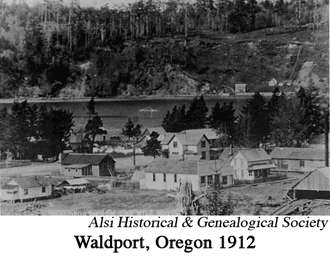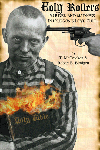 While
doing research for a book you learn all sorts of fascinating
stuff that never gets beyond your yellow note pad or,
assuming you have a good editor, beyond your rough draft.
Such was the case with information I gathered about
Waldport, OR while writing Holy Rollers: Murder and
Madness in Oregon's Love Cult.
While
doing research for a book you learn all sorts of fascinating
stuff that never gets beyond your yellow note pad or,
assuming you have a good editor, beyond your rough draft.
Such was the case with information I gathered about
Waldport, OR while writing Holy Rollers: Murder and
Madness in Oregon's Love Cult.
I was particularly interested in Waldport history because that's where I live. However, since only a couple of chapters of the story took place in Waldport, only a limited amount of the information I gleaned was included in the final text.
With the web, though, anyone who can't get enough about small town coastal life and history, should read on.
***
 I live in on land that Sarah Hurt,
Creffield's mother-in-law squatted on. She, like most of the
people involved in Franz Edmund Creffield's cult were raised
on the Oregon coast. In 1873, when Sarah was twelve, she and
her parents, George and Elizabeth Starr and her four
siblings--Georgianah, thirteen, Oscar, ten, Clarence, six,
and Burgess, two--moved to the Oregon Coast Indian
Reservation. It was a rough trip. The Starrs followed an
Indian trail from Corvallis over the Coast Range to the
Alsea River. There, they made a barge and with their
belongings floated down the river until they reached "White
Town," a settlement that would soon be called Bayview.
Across the bay from White Town was "Indian Town," which
would soon be called Waldport.
I live in on land that Sarah Hurt,
Creffield's mother-in-law squatted on. She, like most of the
people involved in Franz Edmund Creffield's cult were raised
on the Oregon coast. In 1873, when Sarah was twelve, she and
her parents, George and Elizabeth Starr and her four
siblings--Georgianah, thirteen, Oscar, ten, Clarence, six,
and Burgess, two--moved to the Oregon Coast Indian
Reservation. It was a rough trip. The Starrs followed an
Indian trail from Corvallis over the Coast Range to the
Alsea River. There, they made a barge and with their
belongings floated down the river until they reached "White
Town," a settlement that would soon be called Bayview.
Across the bay from White Town was "Indian Town," which
would soon be called Waldport.
The Starrs' first home in Bayview was an old Indian hut. All the cooking was done outside because the hut was very small. When bread was baking, the aroma attracted Indians who would come and eat, and wouldn't leave until it was all gone. At the time the Starrs arrived, the region was still part of the Siletz Indian Reservation and was closed to non-Indian settlement. The Starrs were, strictly speaking, trespassers and were called squatters. They and other non-Indians lived in the area with the permission of their Indian neighbors and of the Indian Agent, Charles Litchfield.
The reservation had been created to accommodate the homesteaders who had come looking for "Eden." Beginning in 1843 thousands of people from the east came to the the Oregon Territory. They came for many reasons, but most came because there was the promise of land--free land that was productive beyond belief. Peter Burnett, later governor of California, said with a twinkle in his eye: "Gentlemen they do say, that out in Oregon the pigs are running about under the great acorn trees, round and fat, and already cooked, with knives and forks sticking in them so that you can cut off a slice whenever you are hungry."
Congress authorized the government to give away hundreds of thousands of acres of land to settlers--white men and women, "American half-breed Indians," and immigrants who had filed for naturalization. There was just one problem--the land belonged to Indians and they still lived on it.
An unratified treaty created the Coast Range Reservation, later known as the Siletz Reservation. At the time, the land was considered worthless. J. W. Perit Huntington, Superintendent of Oregon Indian Affairs, described the land the reservation was on:
- The Coast Reservation was selected by the late Superintendent Joel Palmer in 1855, at a time when the Western slope of the Coast Mountains had been but partially explored, and was supposed to be nearly or quite worthless. The only valleys suitable for human habitation then known to exist were needed for the occupancy of the Indians, and those best informed believed that the rugged nature of the Coast Range of mountains would forever debar the population of the Willamette Valley from using the harbors which were found at the estuaries of the Sinselaw [Siuslaw], Alsea, Tillamook, and Yaquina rivers. Under this belief it was quite natural that little regard should be paid to economy in appropriating territory which was considered so valueless, and consequently the Coast Range was made very large, extending north and south about a hundred miles, and averaging in breadth about twenty."
The Siletz Reservation was created at a time when the government was trying to "civilize" Indians. "Civilized" people were Christians who tilled the soil, wore cotton or wool clothing, and spoke English. The early years on the reservation were hard ones for both the Indians and those who worked for the Indian Agency. H. R. Dunbar, a teacher on the reservation, viewed the place as a "God-forsaken region" of floods, foul weather, loneliness and personality conflicts. "No one that thinks anything of his family," he wrote, "and that has never stepped in such a hole as this with his family absent from him, can realize what it is to stop in this lonesome, wicked place."
Nevertheless, by 1864 non-Indians wanted to settle in the region. The government appropriated $16,500 to purchase Yaquina Bay and land around it from those living there. Speculators came before all of the Indians had been moved out. George Collins, an Indian Agent, described one series of transactions:
- "A" walked into Coquille John's hut on Coquille Point, informed him with the untutored mind that the land belonged to the whites, hustled the Indians out and seated himself on a soap box by the fire. In less than an hour "B" arrived on the scene, gave "A" eighty dollars for his claim. "A" jumped into his canoe and quickly had another claim.
In 1875 the Alsea Indian Sub-agency was closed, and more Indian land was opened to non-Indian settlement. Knowing another land rush would soon ensue, Sarah Starr and her mother rode posthaste on horseback to post notice that they were laying claim to the two-story residence the Indian Agent was vacating and the surrounding forty-nine acres that already had potatoes and wheat growing on them.
This was the start of the settlement of Ocean View, which eventually became the town of Yachats.
In April of 1880 O. V. Hurt and Sarah Starr were married and in September, Maud was born. They had two other children while living on the coast--Frank in 1882, and Mae in 1886. They homesteaded in back of the Indian Agency until, in 1888, the Starrs sold their homestead to the Hosfords. For several years after that, Hurt was the industrial teacher at the Reservation school, and Sarah was the school matron. A government policy in 1870 parceled out reservations among Christian denominations. The Methodists were given responsibility for the staffing at the Siletz Reservation.
- In 1893 there there was a great deal of disharmony among those working for the Indian Agency, and a number of employees left, including the Hurts. They moved to Corvallis, where they all eventually fell under Creffield's spell.
-
Chapters from
Holy Rollers: Murder & Madness in Oregon's Love Cult
Part 1: The Seduction
Chapter 1: Trust Me, Brothers And Sisters
(Life Before Creffield [B.C.])
Chapter 2: God, Save Us From Compromising Preachers
(Creffield's Preachings)
Chapter 3: The Flock
(Profiles of the Holy Rollers Were)
Chapter 4: The Holy Rollers
(Things Start to Get Wild on on Kiger Island)
Chapter 5: Housecleaning
(There's a Sacrificial Bonfire)
Chapter 6: Community Concerns
(Officers Visit)
Chapter 7: Esther, The Chosen One
(Creffield Plans to Marry 16-Year- Old)
Chapter 8: Tar and Feathers
(The Men of Corvallis Act)
Chapter 9: Sane People Don’t Go Bareheaded
(Holy Rollers are Committed to the Asylum)
Chapter 10: More Beast Than Man
( Creffield is Arrested)
Chapter 11: God Will Plead Creffield's Case
(Creffield in Court)
Chapter 12: Scandal
(Shocking Testimony at the Trial)
Chapter 13: Calm Before the Storm
(The Holy Rollers Resume their Lives)
Chapter 14: Giving Up The Ghost
(Men are Gunning for Creffield)
Part Two: The People V. Creffield
Chapter 16: The Widow Creffield
Chapter 19: An Inherited Streak of Insanity
Part Three: The Madness
Chapter 23: Seeking Reconciliation
Chapter 24: Another Holy Roller Page One Murder
Chapter 25: What Can Papa Do For You?
Chapter 26: Human Life is Too Cheap In This Community
Chapter 30: The Final Chapter
(What Happened to Everyone Afterwards)
The Epilogue
(Heaven's Gate)
Chapter of Holy Rollers where much of the action takes place in Waldport
Chapter 14: Men are Gunning for Creffield
